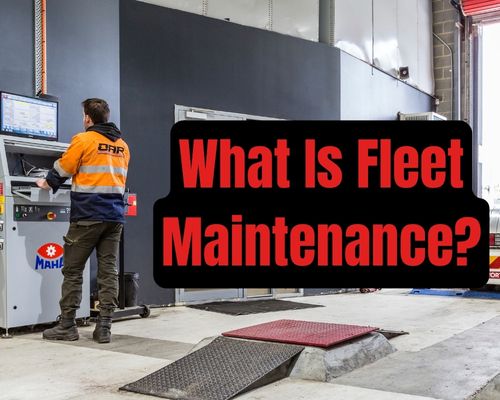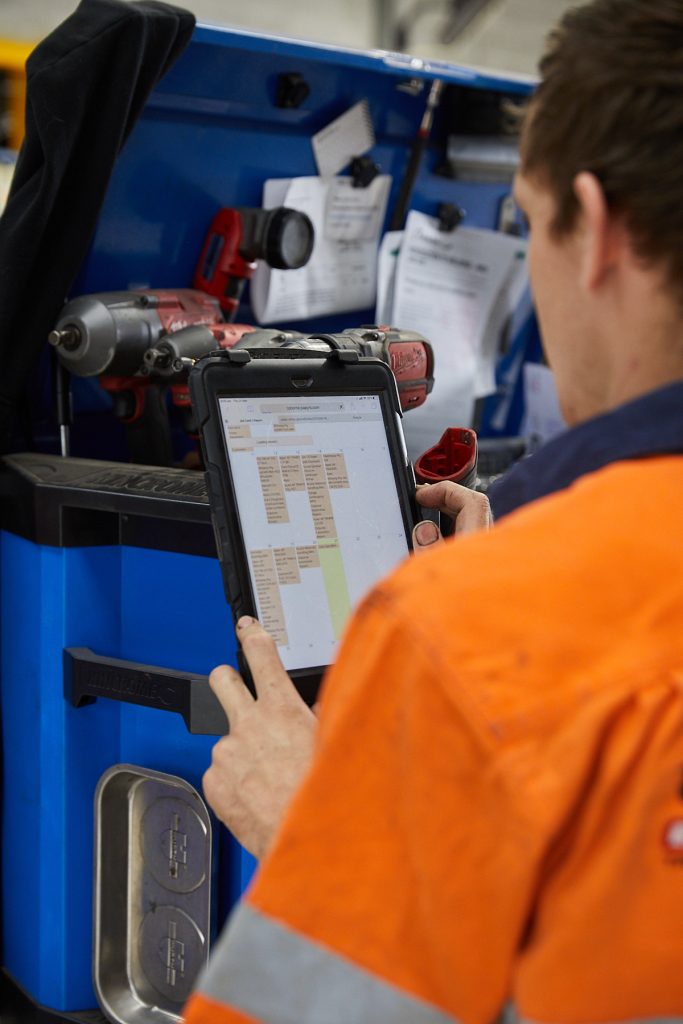
Fleet maintenance involves the procedures and activities required to keep a fleet of vehicles in optimal condition. It ensures that each vehicle is safe to operate, performs efficiently, and is reliable over its working life. These vehicles can range from company cars and delivery trucks to heavy machinery.
Your approach to fleet maintenance not only affects the longevity of the vehicles but can also significantly impact your business’s operating costs and overall productivity.
Understanding the numerous benefits of fleet maintenance is crucial to managing a cost-effective operation. Properly maintained vehicles tend to have a longer life span, experience fewer breakdowns and require less expensive repairs over time. In addition, a well-maintained fleet reduces the risk of accidents caused by vehicle failure, promoting the safety of the drivers and the general public. Efficient fleet maintenance also contributes to better fuel economy and reduces the downtime of vehicles, ensuring that your fleet remains reliable and ready to fulfil its intended roles.
Keeping a regular maintenance schedule allows you to anticipate and manage potential vehicle issues before they develop into serious problems. This approach not only saves you money in the long run but also preserves the resale value of your fleet. By investing in fleet maintenance, you’re ensuring that your vehicles remain in peak condition, reducing the likelihood of interruptions to your business operations.

Before diving into fleet maintenance, it’s crucial to recognise that it is a strategic approach ensuring all your vehicles are in perfect working order and effectively managed. It’s about more than just repairs; it encompasses comprehensive management to extend the lifecycle and efficiency of your fleet.
Fleet maintenance is the cornerstone of fleet management. It involves regular inspections and preventative measures to keep vehicles safe and operational. This proactive approach is designed to identify issues before they become significant problems, reducing downtime and minimising costs. Key components include:
By staying on top of these elements, you contribute to the operational reliability of your fleet, thus safeguarding your business’s productivity.
As a fleet manager, your role is multifaceted. You’re responsible for the strategic planning and execution of fleet maintenance management, which has direct implications on the bottom line. Your responsibilities include:
In executing your duties, your ultimate goal is to maximise fleet performance and cost-efficiency while maintaining high safety standards.

Successfully managing fleet maintenance demands a strategic approach to ensure reliability, minimise downtime, and control costs. Your maintenance strategy consists of both scheduled and unscheduled tasks designed to keep your fleet in prime condition.
Creating a maintenance schedule is critical for the longevity and efficiency of your fleet. You’ll need to consider the manufacturer’s recommendations, the unique demands of your operations, and regulatory compliance requirements. A maintenance plan should include regular service intervals, inspections, and specific tasks to be performed—ensuring that nothing is overlooked. Central to this is having a comprehensive fleet maintenance program which details all these aspects in a structured format.
Implementing a digital maintenance schedule can streamline this process, ensuring you stay ahead of any potential vehicle issues.
Preventive maintenance is about addressing potential issues before they evolve into more significant problems. This approach can include changing the oil, checking tyre treads, and replacing air filters at predetermined intervals. It’s about being proactive rather than waiting for a breakdown to occur.
By contrast, reactive maintenance jumps into action following a failure. While not the preferred approach, it’s a necessary component of any maintenance plan, as some issues are unforeseen. Balancing both preventive and reactive strategies will contribute to a more robust and reliable fleet upkeep.
To ensure your fleet remains in top condition, you need a robust approach to vehicle servicing and operational upkeep. This encompasses a range of practices from regular maintenance tasks to detailed inspections.
Your fleet’s regular maintenance schedule should include timely oil changes, tyre rotations, and checking and replacing fluids. These tasks are crucial for keeping your vehicles running smoothly. By performing these services routinely, you’re likely to catch issues before they become significant problems.
In addition to routine upkeep, major system inspections are vital. These include examining the brake system, transmission, and engine components. By engaging with a qualified service provider, you enable thorough checks that can uncover underlying issues.
Keeping meticulous maintenance history records is more than just organisation—it’s a strategic approach that impacts your entire operation. Comprehensive logs allow you to track servicing, repairs, and part replacements, which is invaluable for planning future maintenance and ensuring compliance with statutory requirements.

In the realm of fleet maintenance, staying ahead means harnessing the power of advanced technologies. From real-time fleet tracking to sophisticated diagnostic data analysis, technology empowers you to maintain your fleet more effectively.
Fleet management systems form the backbone of modern fleet maintenance strategies. They provide real-time tracking, ensuring that you can always know the location and status of your vehicles. Here’s what they offer:
By adopting comprehensive fleet management solutions, you stand to significantly enhance the efficiency and reliability of your fleet operations.
Fleet maintenance software takes the data provided by your fleet management systems to the next level:
Case in point, technological integration in fleet maintenance doesn’t just streamline processes—it drastically improves your fleet’s operational lifespan and helps in cutting costs by ensuring that vehicles are only serviced when needed, based on precise data-driven insights.
Effective fleet maintenance is crucial for minimising vehicle downtime and ensuring timely repairs. By focusing on these goals, you can expect positive vehicle inspection outcomes and maintain a more reliable fleet.
To minimise vehicle downtime, you must implement a proactive maintenance schedule. This involves regular checks and servicing based on the manufacturer’s guidelines or even more frequently, depending on your vehicles’ usage. Use a detailed maintenance checklist to regularly assess the condition of key components. If you identify potential issues early, you can avoid lengthy downtime and reduce the likelihood of unexpected breakdowns. Employing fleet maintenance software, like the one from Fleet Maintenance Software, can streamline this process by providing service reminders and tracking maintenance history.
Key areas to focus on include:
When repairs are necessary, having a strategy to ensure they are conducted in a timely manner is paramount. Establish a network of trusted repair vendors who understand the urgency of getting your vehicles back on the road. Ensure that parts inventory is well-managed to prevent delays in the repair process. Moreover, training your drivers to recognise early signs of mechanical issues allows for immediate action, which can lead to quicker turnaround times for repairs.
Practical steps include:
In managing your fleet, it’s vital to understand that fleet maintenance significantly affects your financials, particularly by influencing operational costs and necessitating a well-planned budget.
Your fleet’s operational costs are directly impacted by maintenance practices. Regular maintenance can lead to substantial savings by preventing costly repairs and downtime. On the flip side, neglecting fleet maintenance escalates repair costs over time. Key components of operational costs include:
Effective budgeting for fleet maintenance requires precision and foresight. Consider the following strategies:
In managing your fleet, you must prioritize safety, navigate the complexity of regulatory compliance, and meticulously adhere to the mandated compliance requirements.
Your diligence affects not only the efficiency and performance of your fleet but also the well-being of your drivers and the public.
Safety sits at the core of fleet maintenance. It’s your responsibility to conduct regular inspections and uphold stringent safety standards.
This includes routinely checking and maintaining safety and emergency equipment like fire extinguishers and first-aid kits.
Every vehicle should adhere to a checklist that includes tyre inspections, brake tests, and the functioning of lights and signals.
In Australia, keeping your fleet in top condition is not just a practice but a legal mandate.
The safety checks are designed to spot potential hazards early on, thus safeguarding all road users.
Your fleet must meet specific regulatory compliance standards that govern operational safety on Australian roads.
Compliance requirements can range from securing the necessary permits for vehicle operation to the documentation of every vehicle’s service history.
Compliance with these regulations is not optional; it’s a critical aspect of legal fleet operation that helps you avoid fines, penalties, and other legal issues.
Stay informed about the latest regulations by referencing authoritative sites such as the Australian Department of Infrastructure.
Ensure that all policies are translated into practical procedures within your maintenance schedule.
In managing your fleet, you’ll find that environmental considerations are pivotal to both sustainable operations and cost savings.
The way you manage fuel consumption has a direct effect on not only the environment but also the bottom line, making it crucial for your fleet.
Fuel efficiency can be substantially improved by regular maintenance. For instance, addressing a single issue such as a faulty oxygen sensor can enhance your vehicle’s mileage by as much as 40 percent.
Engaging with a common maintenance vendor for all vehicles is a strategy that streamlines this process.
Minimizing your fleet’s economic footprint is more than just a regulatory requirement; it’s a commitment to future generations.
It encompasses everything from the selection of eco-friendlier vehicles to the disposal of wastes in a responsible manner.
In managing your fleet, your focus on maximizing the durability of your vehicles and optimizing their operational efficiency can significantly enhance productivity and ensure reliability.
To maximize the lifespan of your fleet vehicles, it’s crucial to adhere to a strict maintenance schedule.
This involves regular check-ups, timely servicing, and immediate attention to any repairs needed.
By prioritizing the health of your fleet, you extend the life of each vehicle and avoid costly breakdowns.
An approach that incorporates both preventive maintenance and predictive strategies can mean fewer disruptions and a more dependable fleet.
For instance, replacing parts before they fail and using high-quality components can reduce the frequency of maintenance and prolong vehicle functionality.
Following the manufacturer’s recommendations for maintenance insights ensures that you stay on top of wear and tear, while keeping your vehicles in prime condition for the long haul.
Optimizing the efficiency of your fleet translates to better fuel economy, less downtime, and improved overall performance.
One key aspect is implementing smart routing with the help of GPS tracking to minimize unnecessary mileage and reduce fuel consumption.
Regularly monitoring tyre pressure and engine performance can also lead to more efficient operation of your vehicles.
Moreover, embracing technology like telematics can provide real-time data to manage and improve driver behavior, route optimization, and vehicle maintenance needs.
By leveraging the latest in fleet management software, you can ensure that your operations are as efficient as possible, yielding higher productivity levels and ensuring optimal performance across your fleet.
Ensuring your fleet remains operational hinges on effective logistics and meticulous inventory management.
Key elements such as parts management and inventory control are fundamental in minimizing downtime and maintaining efficiency.
Your approach to parts management should be proactive. Precisely track and order spare parts necessary for routine maintenance and unexpected repairs.
This includes filters, tyres, and essential engine components.
Establish a system that alerts you when inventory is low. This ensures that parts are replenished promptly to avoid service disruptions.
Inventory control is a balancing act between having enough spares to prevent delays and not overstocking, which ties up capital.
Implement an inventory management system that monitors stock levels in real-time. Use data analysis to forecast future needs based on usage patterns and service schedules.
Your fleet’s maintenance strategies have a direct impact on how satisfied your customers are with your service.
A well-maintained fleet ensures reliability and can significantly bolster your company’s reputation.
By prioritizing fleet maintenance, you’re directly enhancing the likelihood of positive service outcomes.
A vehicle that is serviced regularly is less prone to breakdowns and can meet delivery and service timelines more consistently.
Satisfied customers often result from experiencing fewer service interruptions and delays.
For instance, consistent fleet maintenance can lead to improved fuel efficiency, which translates to cost savings that can be passed on to the customer, further promoting satisfaction.
Fleet providers play a crucial role in fostering strong client relations. Their expertise in administering comprehensive maintenance not only elevates the performance of the fleet but also instills a sense of trust and reliability among customers.
When your service provider ensures your fleet meets the highest standards, your clients experience the benefits through better service quality.
Leading providers often offer fleet maintenance services that aim to optimize vehicular health and enhance overall operations, which is central to achieving superior customer satisfaction.
Within fleet maintenance, the human element plays a pivotal role in ensuring vehicle uptime and operational efficiency. Your drivers and maintenance team are the foundation of a robust fleet management strategy.
Driver training is critical in fleet maintenance as it directly influences how vehicles are operated on a daily basis.
With the right training, your drivers become adept at identifying early signs of vehicle wear and tear, which can prevent more serious issues from developing.
Their awareness can contribute to reducing the need for repairs, thus avoiding unnecessary downtime.
Periodic driver education sessions on vehicle care and protocols can result in safer driving practices, and ultimately, prolonging the life span of your fleet.
Mechanics and technicians are irreplaceable in their ability to keep your fleet running smoothly.
Their technical expertise ensures that each vehicle receives the attention it needs, from regular maintenance to complex repairs.
Leveraging their skill sets can lead to improved vehicle reliability and reduced long-term costs.
They utilize their extensive knowledge to troubleshoot problems quickly and efficiently, making sure your vehicles are back on the road with minimal disruption.
It’s crucial to invest in continuous professional development for your mechanics and technicians to stay abreast of evolving automotive technologies.
Fleet maintenance is on the brink of significant transformations, largely driven by advancements in technology.
With an investment in revolutionary fleet management software and mobile app solutions, you’re set to experience these changes firsthand.
In exploring fleet maintenance, you’ll encounter a range of tasks and strategies that are crucial for optimizing vehicle performance and longevity. Listed below are specific aspects and duties that define effective fleet maintenance operations.
In a fleet maintenance job, you’re responsible for managing a series of scheduled tasks, such as vehicle inspections, servicing, repairs, and inventory management. These activities collectively ensure that each vehicle is operating safely and efficiently.
A fleet maintenance program streamlines operational efficiency by reducing vehicle downtime, minimizing repair costs, and optimizing the scheduling of maintenance activities. It allows for proactive vehicle management, leading to fewer unexpected breakdowns and disruptions.
A thorough fleet maintenance checklist includes regular inspections of engine performance, tire pressures, brake systems, fluid levels, and electrical components. Each vehicle’s manufacturer will provide specific guidelines, but the checklist should be tailored to the particular demands of your fleet’s operation.
There are several types of fleet maintenance strategies, including reactive, preventive, predictive, and condition-based maintenance. Each strategy has a different approach to vehicle upkeep, with preventive maintenance being particularly effective in maintaining fuel efficiency.
Fleet maintenance services contribute to vehicle longevity by ensuring that vehicles are kept in optimal operating condition, thereby preventing excessive wear and tear. Regular maintenance extends the life span of vehicles and supports their resale value.
A fleet maintenance officer typically undertakes responsibilities such as scheduling service appointments. They also oversee maintenance work, manage parts inventories, and ensure compliance with safety regulations.
They also play a crucial role in analysing maintenance data. This helps them make informed decisions regarding fleet management.